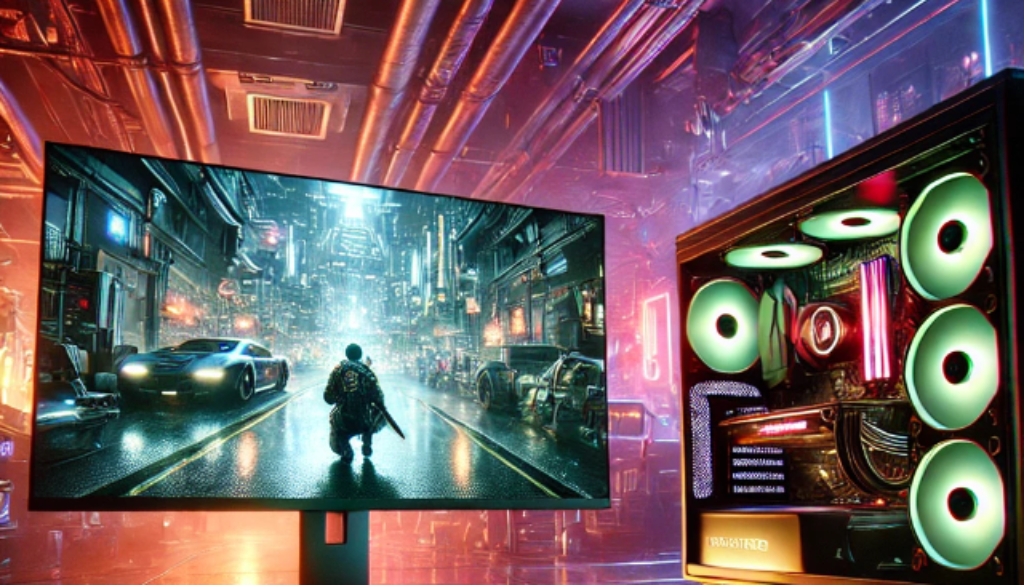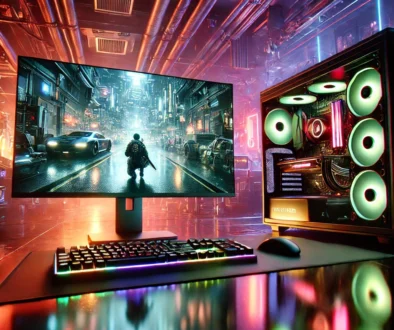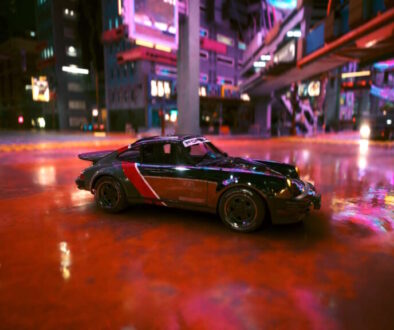Ray Tracing Explained: Is It Worth the Performance Hit in 2024?
When you purchase through links on our website, we may earn an affiliate commission.

Imagine playing a game so realistic, you can’t tell it apart from reality. That’s the promise of ray tracing, folks! As a lifelong gamer and tech enthusiast, I’ve seen graphics evolve from blocky pixels to photorealistic landscapes. But ray tracing? It’s a whole new ballgame.
I remember the first time I enabled ray tracing in Cyberpunk 2077. My jaw hit the floor faster than my frame rate! Those neon-lit puddles reflecting the bustling city streets… it was like I could reach out and touch Night City. But then I checked my FPS counter, and boy, was I in for a reality check.
That’s the thing about ray tracing – it’s drop-dead gorgeous, but it comes at a cost. And in 2024, we’re still asking the million-dollar question: Is ray tracing worth the performance hit?
In this article, I’m going to break down what ray tracing is, how it impacts your gaming experience, and whether it’s worth cranking up in 2024. Trust me, I’ve spent more hours than I’d like to admit tweaking settings and running benchmarks, so you don’t have to!
What is Ray Tracing and How Does it Work?
Alright, let’s get a bit nerdy for a second – but I promise to keep it fun! Ray tracing is like the Rolls Royce of lighting techniques in computer graphics. Instead of faking lighting effects (which games have been doing pretty darn well for years), ray tracing simulates the actual behavior of light.
Think of it this way: Imagine you’re playing paintball, but instead of shooting paint, you’re firing millions of tiny light rays. These rays bounce around the environment, picking up colors and lighting information as they go. When they hit your eyes (or in this case, the virtual camera), boom! You get an incredibly realistic image.
Now, traditional rasterization – the technique games have been using forever – is more like painting a really detailed picture. It’s fast, it looks good, but it’s not quite the real deal. Ray tracing, on the other hand, is like hiring a world-class photographer to capture the scene in perfect detail.
Here’s where it gets cool (and computationally expensive). Ray tracing isn’t just one thing – it’s a bunch of techniques working together:
- Ray-traced reflections: Ever noticed how puddles in games sometimes don’t reflect everything around them? Ray tracing fixes that. I’ll never forget the first time I saw accurate reflections in Control – it was like my GPU was performing magic!
- Ray-traced shadows: Say goodbye to those weird, blocky shadows. Ray-traced shadows are soft, realistic, and change dynamically. It’s subtle, but once you see it, you can’t unsee it.
- Global illumination: This is the holy grail of lighting. It simulates how light bounces off surfaces and affects other objects. The result? Scenes that look so natural, you’ll forget you’re playing a game.
But here’s the kicker – all this awesomeness comes at a price. Your GPU has to calculate all these light rays in real-time, and let me tell you, that’s no small feat. It’s like asking your brain to predict where every raindrop will land in a storm while you’re trying to win a chess match.
When I first enabled full ray tracing in Metro Exodus Enhanced Edition, I swear I could hear my GPU fan kick into overdrive. The visuals were stunning, but my poor RTX 3070 was sweating bullets trying to keep up!
So, is it worth it? Well, that’s the million-dollar question, isn’t it? In the next sections, we’ll dive into the nitty-gritty of performance impacts, visual improvements, and whether your eyes (and your wallet) will thank you for embracing ray tracing in 2024.
The Evolution of Ray Tracing in Gaming
Boy, has ray tracing come a long way! I remember when it was just a pipe dream for real-time graphics. Back in the day, we’d ooh and aah over pre-rendered CGI in movies, never imagining we’d see that level of realism in games.
The journey hasn’t been smooth sailing, though. Early implementations of ray tracing were… well, let’s just say they were more slideshow than game. I tried running Quake II RTX on my old GTX 1060, and I think I aged a year waiting for each frame to render!
But then came the game-changer: hardware-accelerated ray tracing. When NVIDIA dropped the RTX 20 series in 2018, it was like someone flipped a switch. Suddenly, ray tracing wasn’t just possible – it was playable!
Since then, we’ve seen some major milestones:
- 2018: NVIDIA RTX 20 series launches with dedicated RT cores
- 2019: Control and Metro Exodus showcase ray tracing’s potential
- 2020: AMD joins the party with RDNA 2 architecture
- 2021: Ray tracing hits consoles with PS5 and Xbox Series X
- 2022: DLSS and FSR make ray tracing more accessible
- 2023: Ray tracing becomes a standard feature in AAA titles
And now, in 2024, we’re seeing ray tracing pop up everywhere from indie gems to esports titles. It’s been a wild ride, and I can’t wait to see where it goes next!
Ray Tracing Performance Impact: By the Numbers
Alright, let’s get down to brass tacks. How much does ray tracing really impact performance? I’ve spent way too many hours benchmarking games (don’t tell my boss), so let me break it down for you.
In 2024, the performance hit isn’t as brutal as it used to be, but it’s still significant. Here’s what I’ve found:
1080p Gaming:
- Entry-level GPUs (RTX 4060, RX 7600): 30-40% FPS drop
- Mid-range GPUs (RTX 4070, RX 7700 XT): 20-30% FPS drop
- High-end GPUs (RTX 4080, RX 7900 XT): 15-25% FPS drop
1440p Gaming:
- Mid-range GPUs (RTX 4070, RX 7700 XT): 25-35% FPS drop
- High-end GPUs (RTX 4080, RX 7900 XT): 20-30% FPS drop
4K Gaming:
- High-end GPUs (RTX 4080, RX 7900 XT): 30-40% FPS drop
- Ultra-high-end GPUs (RTX 4090, RX 7900 XTX): 25-35% FPS drop
These numbers can vary wildly depending on the game and specific ray tracing effects used. For instance, Cyberpunk 2077 with full ray tracing still brings even the mightiest GPUs to their knees, while something like Fortnite with ray-traced shadows is much easier to run.
The good news? These numbers are way better than what we saw a few years ago. Remember when enabling ray tracing meant kissing smooth gameplay goodbye? We’ve come a long way, baby!
Visual Improvements: Is the Difference Noticeable?
Now for the million-dollar question: Does ray tracing actually look better, or is it just a fancy buzzword?
In my experience, the answer is… it depends. Sometimes, ray tracing is like putting on glasses for the first time – you wonder how you ever lived without it. Other times, it’s more subtle, and you might not notice unless you’re really looking for it.
Let’s break it down by genre:
- Open World Games: This is where ray tracing really shines. Games like Cyberpunk 2077 and Watch Dogs: Legion look absolutely stunning with ray tracing enabled. The reflections in puddles and windows, the way light bounces off different surfaces – it’s genuinely breathtaking.
- Horror Games: Ray-traced shadows and global illumination can make dark, spooky environments feel so much more atmospheric. I nearly jumped out of my skin playing Resident Evil Village with ray tracing on!
- Fast-Paced Shooters: Here, the difference is less noticeable. In the heat of battle in Call of Duty or Apex Legends, you might not have time to appreciate those ray-traced reflections.
- Racing Games: Ray tracing can make a huge difference here, especially in games like Forza Horizon 5. The reflections on car bodies and wet roads are just chef’s kiss.
- Indie Games: Some indie devs are doing amazing things with ray tracing. Bright Memory: Infinite, for instance, looks incredibly polished for a small-team production.
The most noticeable improvements are often in reflections and global illumination. Ray-traced shadows can be subtle, but once you notice them, it’s hard to go back.
Pro tip: To really appreciate the difference, try taking screenshots with ray tracing on and off. It’s like one of those “spot the difference” games, but way cooler!
Mitigating the Performance Hit: DLSS and FSR
Thank god for AI upscaling! Without technologies like NVIDIA’s DLSS (Deep Learning Super Sampling) and AMD’s FSR (FidelityFX Super Resolution), we’d still be choosing between ray tracing and playable frame rates.
Here’s how these magical technologies work:
- DLSS: This NVIDIA-exclusive tech uses AI to render the game at a lower resolution, then upscale it to your target resolution. It’s like having a tiny art restorer in your GPU, filling in the details.
- FSR: AMD’s answer to DLSS works a bit differently. It’s not AI-based, but it still does a great job of upscaling. The best part? It works on a wide range of GPUs, not just AMD’s.
In my testing, enabling DLSS or FSR can often completely offset the performance hit from ray tracing, sometimes even giving you better performance than native resolution without ray tracing!
For example, in Cyberpunk 2077 at 1440p on an RTX 4070:
- Native resolution, no RT: 85 FPS
- Native resolution with RT: 55 FPS
- DLSS Quality with RT: 80 FPS
It’s not perfect – you might notice some artifacts or softness in motion – but the trade-off is usually worth it. Plus, these technologies keep getting better with each iteration.
Ray Tracing on Different GPU Architectures
Not all ray tracing is created equal. Let’s break down how different GPU architectures handle this demanding technology:
NVIDIA RTX:
- The OG of hardware ray tracing
- Dedicated RT cores make a big difference
- Best performance in most ray-traced games
- DLSS is a game-changer for performance
AMD RDNA 2 and 3:
- Caught up significantly with RDNA 3
- Ray tracing performance gap with NVIDIA has narrowed
- FSR works well, but not quite as magical as DLSS
- Often better rasterization performance, if you’re not using RT
Intel Arc:
- The new kid on the block
- Surprisingly good ray tracing performance for a first attempt
- XeSS upscaling tech is promising
- Still needs driver optimization in many games
Looking ahead, we’re seeing some exciting developments. NVIDIA’s rumored next-gen architecture promises even better ray tracing performance, while AMD is doubling down on their ray tracing capabilities. And let’s not forget about mobile ray tracing – it’s getting better every year!
Is Ray Tracing Worth It in 2024?
After spending way too much time (and probably electricity) testing ray tracing, here’s my verdict: It’s worth it… sometimes.
Pros of enabling ray tracing:
- Stunning visual improvements in the right games
- More immersive and realistic environments
- Future-proofing your gaming experience
- Bragging rights (admit it, we all like those)
Cons of enabling ray tracing:
- Significant performance hit, especially at higher resolutions
- Not all games implement it well
- Can be distracting in fast-paced games
- Requires a relatively recent, powerful GPU
So, when should you flip that ray tracing switch?
- Single-player, visually-rich games: Absolutely. Take your time, smell the ray-traced roses.
- Competitive multiplayer games: Probably not. Frames win games, after all.
- If you have DLSS or FSR available: Go for it. You can have your cake and eat it too.
- On mid-range hardware at 1080p: It’s worth experimenting with.
- On high-end hardware at 4K: If you’ve got the horsepower, why not?
Remember, there’s no one-size-fits-all answer. I encourage you to experiment, tweak those settings, and find what works best for you and your setup.
Conclusion
Whew, we’ve come a long way in our ray tracing journey! From its humble, slideshow-like beginnings to the stunning, real-time lighting effects we see today, ray tracing has truly transformed the gaming landscape.
Is it worth the performance hit in 2024? Well, that depends on your priorities, your hardware, and the games you play. But one thing’s for sure – ray tracing is here to stay, and it’s only going to get better.
My advice? Don’t be afraid to experiment. Toggle that ray tracing option on and off, play with DLSS or FSR settings, and see what works for you. After all, the joy of PC gaming is in the tinkering, right?
And hey, even if you decide ray tracing isn’t for you right now, it’s exciting to think about where this technology might take us in the future. Who knows? Maybe in a few years, we’ll look back at 2024’s ray tracing the same way we now look at 2004’s normal mapping – as just the beginning of something amazing.
So go forth, fellow gamers! Embrace the rays, chase those frames, and most importantly, have fun. Because at the end of the day, that’s what it’s all about. Happy gaming, and may your frame rates be high and your temperatures low!



Introduction to Ray Tracing: Revolutionizing Graphics in 2024 -
August 14, 2024 @ 4:37 pm
[…] the performance hit, especially in 2024, you might want to check out this detailed breakdown on Ray Tracing Explained. It goes deep into whether the visual payoff is worth the hardware demands, something we’ll also […]
Top 5 Budget-Friendly Graphics Cards for 1080p Gaming in 2024 -
August 22, 2024 @ 9:20 am
[…] If you’re curious about whether ray tracing is worth the performance hit in 2024, check out this detailed explanation. Plus, the power efficiency is a big win—my electricity bill hasn’t spiked, and my PC isn’t […]
Ray Tracing vs. DLSS: Which Technology Impacts FPS More in 2024? -
August 28, 2024 @ 12:24 am
[…] a cost. The performance impact of enabling ray tracing can be pretty significant. Many gamers wonder if ray tracing is worth the performance hit, especially as we move into 2024. In my experience, turning on ray tracing can lead to anywhere […]
Understanding GPU Specs: A Comprehensive Guide for Budget Gamers in 2024 -
September 4, 2024 @ 4:01 pm
[…] Ray tracing creates ultra-realistic lighting, reflections, and shadows. It looks amazing… when your GPU can handle it. The catch? It’s a performance hog. On a budget GPU, enabling ray tracing often means watching your frame rate plummet faster than my hopes of ever affording a 4090. […]
Best GPUs to Buy in 2024 -
December 3, 2024 @ 11:37 am
[…] and professional workloads. The rapid pace of technological innovation, including advancements in ray tracing, and AI-based upscaling makes this year particularly exciting for GPU […]
Intel Arc B580 Review -
December 20, 2024 @ 6:04 am
[…] reveal key performance trends for the Arc B580. In rasterization scenarios (performance without ray tracing), the B580 demonstrates a clear advantage over some of its direct competitors. On average, […]
AMD Radeon RX 6600 vs. Intel Arc B580: Has the Budget King Been Dethroned? -
December 28, 2024 @ 1:28 pm
[…] also conducted limited testing with ray tracing enabled in two selected titles. We want to emphasize that at this price point, ray tracing is […]
RTX 5090 Review: Is Nvidia’s Next-Gen GPU Worth the Upgrade? -
January 30, 2025 @ 9:40 am
[…] terms of ray tracing, Nvidia has doubled the ray/triangle intersection per cycle in the RTX 5090. The boost in ray […]
RTX 5090 Review: Is Nvidia’s Next-Gen GPU Worth the Upgrade?
January 30, 2025 @ 9:42 am
[…] terms of ray tracing, Nvidia has doubled the ray/triangle intersection per cycle in the RTX 5090. The boost in ray […]
NVIDIA GeForce RTX 5080 Review: The Next Big Leap or a Gimmick?
February 9, 2025 @ 5:50 am
[…] cases where it can cause performance bottlenecks, particularly in memory-intensive workloads like ray tracing and high-resolution texture packs. The fact that the AMD Radeon RX 7900 XTX offers 24GB of VRAM at […]